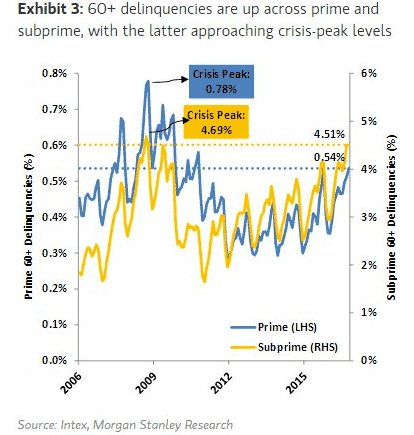Subprime auto delinquency rate at highest level since financial crisis
I have been meaning to post the following chart from Morgan Stanley on the auto sector. It shows subprime auto delinquencies now at levels last seen during the Great Financial Crisis.

Source: Tracy Alloway – Bloomberg, Morgan Stanley
Now, I have been harping on this for a while, because of the inventory builds and declining prices we are seeing in the auto sector. And more recently, we saw Ally Financial warn on profits too. That’s a big red flag.
So I took a look at what regulators were saying about lending standards in the sector in the Office of the Comptroller of the Currency’s most recent Semiannual Risk Perspective. The OCC is a major US bank regulator charged with watching whether deteriorating lending standards could undermine banks’ future lending by building up potential future loan losses.
Here are a few verbatim excerpts from the Fall 2016 report (PDF here). Note the comments on commercial real estate here as well. I have bolded the key parts.
- “Continued incremental easing in underwriting standards is a concern as banks strive to achieve loan growth and to maintain or grow market share. Easing of underwriting standards in commercial, CRE, and auto lending presents increasing credit risk”
- “Rapid CRE loan growth over the past year and recent underwriting reviews raise concern over the quality of CRE risk management, particularly managing concentrations.”
- “Weak underwriting and erosion of covenant protection remain supervisory concerns in leveraged lending.”
- “Auto lending risk has been increasing for several quarters because of notable and unprecedented growth across all types of lenders. In the last two quarters, delinquencies on auto loans have begun to increase and net losses have also reflected non-seasonal increases. As banks competed for market share, some banks responded with less stringent underwriting standards for direct and indirect auto loans. In addition to the eased underwriting standards, lenders also substantially layered risks (granted longer terms combined with higher advance rates resulting in higher LTV ratios). These factors increased the credit risk in auto loan portfolios, as well as creating potential fair lending and consumer compliance concerns. This embedded risk is now being reflected in lower recoveries at charge-off (higher loss severities) for both bank loans and securitized auto loans despite relative stability in used auto values (see figure 12). Bank risk management practices and the ALLL should reflect the elevated risk profile and higher probable credit loss severities. Supervisory work in some banks has identified risk management practices that have not kept pace with the growth and increased risk in these portfolios.”
Why it matters: The big three areas of credit expansion this cycle – energy, auto and student loans – are not of the magnitude of the housing sector in the last cycle. Not only is the mortgage sector bigger, it was international in scope, adding significantly to systemic risk by undermining the balance sheets of European banks as well as American ones.
Nevertheless, increased delinquencies in the auto sector will spell trouble given the high LTVs of loans and lower credit scores of borrowers. And I am troubled by the OCC’s depiction of the commercial real estate sector; we could see heavy loan losses there in the next downturn.
On autos, High LTVs mean lower recovery values for a depreciating asset. And this will be compounded by falling prices given the glut of production, now buoyed by subprime auto financing. And this will have a negative impact on the auto sector and the US economy. The question on a pullback in auto loans is timing; it’s not if, it is when and how hard — and how much this will impact bank balance sheets and the economy.
Comments are closed.